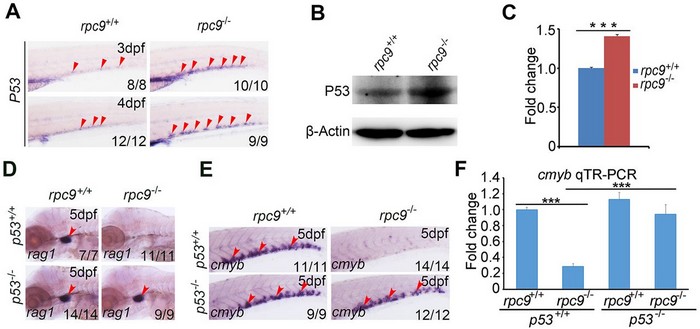Scientists identified a new role of RNA polymerase III complex in regulating hematopoietic stem and progenitor cell maintenance
DNA-directed RNA polymerase III complex (Pol III) is a specialized enzyme responsible for transcription of small noncoding RNAs (snRNAs) including 5S rRNA, tRNAs and 7SL RNA etc. It is the most complex RNA polymerase that comprises of 17 subunits with a total molecular weight of about 700 kDa. The major function of Pol III in protein synthesis is well-known, but its role in developmental hematopoiesis has not been reported.
The Hematopoiesis and Cardiovascular Development Group led by Prof. Feng Liu found that rpc9, a gene encoding a component of Pol III, is responsible for the phenotype in a zebrafish mutant, in which hematopoietic stem and progenitor cell (HSPC) development was severely impaired during embryogenesis. Further analysis showed that rpc9-deficiency leads to excessive apoptosis in the caudal hematopoietic tissue (CHT, the equivalent of fetal liver in mammals). Moreover, suppression of p53 can alleviate apoptosis in the CHT region and fully rescue the hematopoietic defects in rpc9-/- mutant embryos, suggesting that rpc9 plays an important tissue-specific role in HSPC development during zebrafish embryogenesis and that it might be conserved across vertebrates including mammals. This work broadens our view on the mechanism of HSPC survival and may provide new clues for the in vitro HSPC maintenance.
This research was supported by grants from the National Basic Research Program of China, the National Natural Science Foundation of China, the Strategic Priority Research Program of the Chinese Academy of Sciences and the Research Grants Council of the HKSAR.
Website: http://dev.biologists.org/content/143/12/2103.long

P53 mediates the regulation of Rpc9 in HSPC survival
